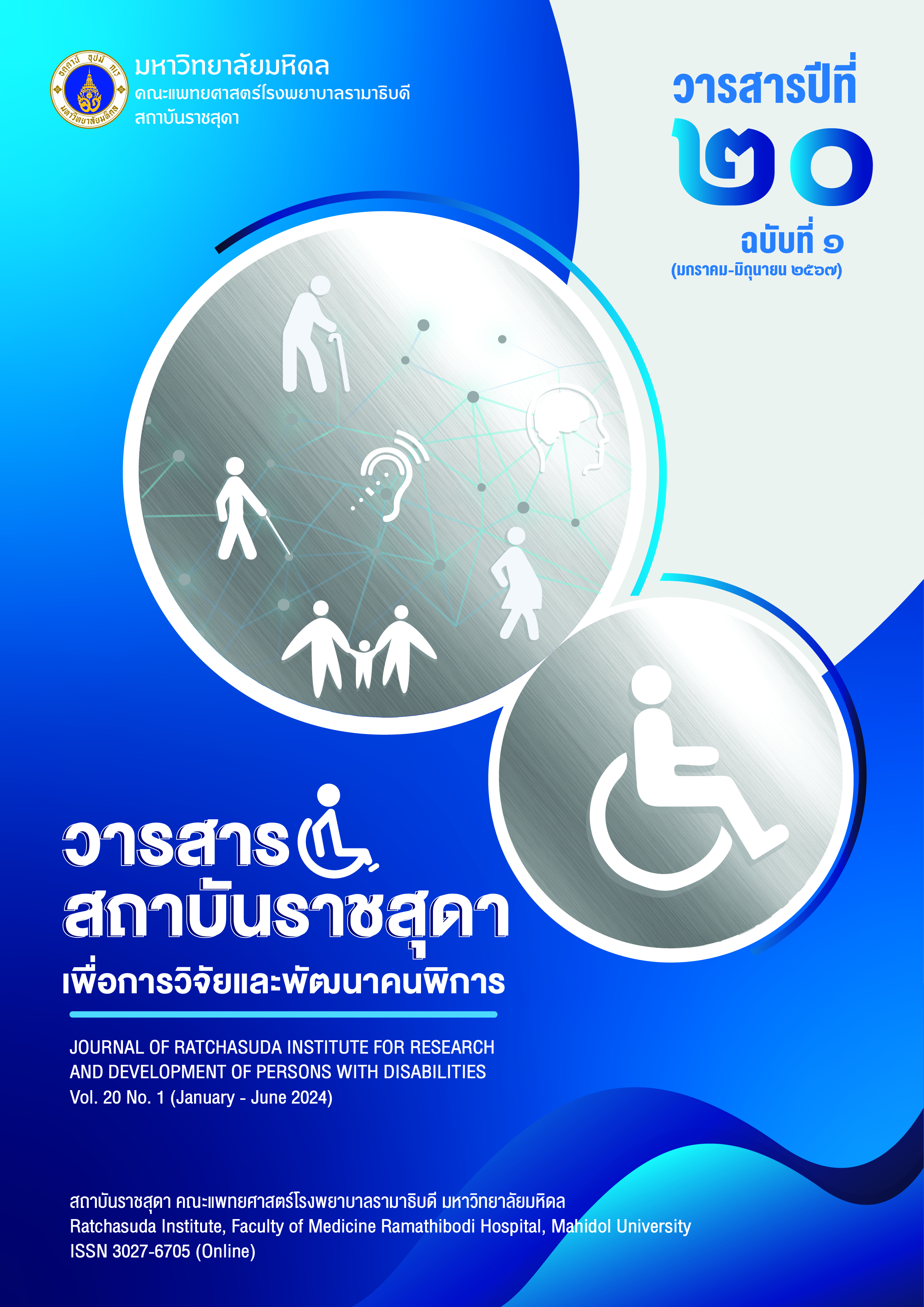Myth of Supercrip and Disability Policies
Keywords:
Supercrip, Disability Policy, People with Disability, Disability Right, StereotypeAbstract
Society often values appreciation for people with disability who are able to overcome the obstacles of their disabilities to achieve what they want. Such people with disability is called ‘Supercrip’. Although in many cases it is only a general achievement that people without disability are able to do that in their daily lives but society always chooses to praise excessively for those basic activities and that becomes myth. This image of success of the Supercrip put some of people with disability under social pressure to be able to act or struggle in the same way. If anyone is not able to do that, they will be made to feel as an outcast by the non-disabled society and will be made to feel inferior from the Supercrips as otherness. However, the excessive praise for engaging in everyday activities is thought to reflect low expectations about what people with disability can achieve. This paper aims to present a new perspective of analysis of policy decision makers. Their attitudes are reflective of the attitudes of society. When society expects a higher degree of efforts from people with disability that would also mean the same expectations of those in power. This leads to the neglect of issues concerning disability policies, on the belief that people with disability deserve to overcome those obstacles on their own as a Supercrip. It resulted to many people with disability to have to choose fighting through policy problems which no authorities are interested in solving until they develop an illness that could become debilitating to themselves or to a family member that leads to a disability themselves hence then trying to become a ‘Supercrip’.
Downloads
References
Berger. (2008). Disability and the dedicated wheelchair athlete: Beyond the ‘Supercrip’ critique. Journal of Contemporary Ethnography, 37(6), 647–678.
Bliss, C. (2017). The super problem with the Supercrip?. Politics, Power, and the Other in Superhero Comics [Conference]. 10th Annual Comics and Popular Arts Conference, Atlanta, GA. https://www.researchgate.net/publication/327603740_The_Super_Problem_with_the_Supercrip/link/5bbe3c3a45851572315ebca5/download?_tp=eyJjb250ZXh0Ijp7ImZpcnN0UGFnZSI6InNpZ251cCIsInBhZ2UiOiJwdWJsaWNhdGlvbiJ9fQ
Brown, J. (2019). Satirizing the Supercrip: Disability in the antagonists. The Journal of Popular and American Culture. 4(1). https://responsejournal.net/issue/2019-06/feature/satirizing-Supercrip-disability-antagonists
Brylla, C. (2018). Bypassing the Supercrip trope in documentary representations of blind visual artists. Disability Studies Quarterly, 38(3). https://doi.org/10.18061/dsq.v38i3.6485
Chalanumas, T. & Panthanuwong, A. (2019). Concepts about the disabled as presented in Thai TV talk show, game show and documentary program. Journal of Communication Arts, 37(2), 75-85.
Charoensuk, C. & Priyakorn, P. (2021). The roles of organizations of disabled people and gov-ernment agencies on the disability right of access to public transportation: A case study on the right of access to low-floor bus. Journal of Politics and Governance, 11(1), 163-178.
Crittenden, S. (2018). The impact of Supercrip representations on attitudes towards people with physical disabilities. Undergraduate Honors Theses. 79. https: //ir.lib.uwo. ca/psychK_uht/79
Disabilities Thailand. (2015). Handbook of producing radio or television programs related to people with disabilities: The proposals from the consumer. Broadcasting Complaint and Consumer Protection Bureau, The Office of the National Broadcasting and Telecommunications Commission (NBTC). http://bcp.nbtc.go.th/uploads/items/attachments/e46de7e1bcaaced9a54f1e9d0d2f800d/_941fc50abbaf88990b25ca1c9aa49e7e.pdf
Grue, J. (2015). The problem of the Supercrip: Representation and misrepresentation of disability. In Shakespeare, T., (Ed.), Disability Research Today: International Perspectives (pp. 204-218). Routledge.
Howe, D. (2011). Cyborg and Supercrip: The Paralympics technology and the (dis)empower-ment of disabled athletes. Sociology, 45(5), 868-882.
Johnson, M. (1989). The ‘super-crip’ stereotype: Press victimization of disabled people. The Newsletter on Journalism Ethics, 1(4), 2. https://ethicscasestudies. mediaschool. indiana.edu/cases/sensitive-news-topics/the-super-crip-stereotype.html
Kama, A. (2004). Supercrips versus the pitiful handicapped: Reception of disabling images by disabled audience members. Communications, 29(4), 447-466.
Lalit, S. (2022). 17 famous people with disabilities in the world. Wecapable. https://wecapable.com/famous-disabled-people-world/
Martin, J. (2017). Supercrip identity. In Martin, J. Handbook of Disability Sport and Exercise Psychology, (pp.139-148). Oxford University Press.
McIeod, S. (2023). Social identity theory: Definition, history, examples, & facts. Simplypsychology. https://www.simplypsychology.org/social-identity-theory.html
RightComedy. (2022, May 29). Wonder hero: Hero never give up [Vedio]. Youtube. https://www.youtube.com/watch?v=rM3hQddsSVEyoung
Sebring, J. (2017). I’m not a ‘Supercrip,’ and that’s ok. Themighty. https://themighty. com/topic/disability/addressing-the-Supercrip-stereotype
Silva, C. & Howe, D. (2012). The (in)validity of Supercrip representation of Paralympian athletes. Journal of Sport & Social Issues, 36(2), 174-194.
Smith, B. & Papathomas, A. (2014). Disability, sport and exercising bodies. In Swain, J., French, S., Barnes, C. & Thomas C., (Eds.) Disabling Barriers-Enabling Environments (3th ed.), (pp. 222-228). SAGE.
Stanley, C. (2015). What I want you to understand about the ‘Supercrip’ stereotype. Themighty. https://themighty.com/topic/blindness/challenging-the-Supercrip-stereotype-of-people-with-disabilities
Suratthani Provincial Social Development and Human Security Office. (2020). 2020 criteria for selecting good people with disability. Department of Empowerment Of Persons With Disabilities.
https://drive.google.com/file/d/126BdvvGq4SoVcRaGnGD1NBQKPpn9d70f/view
Tarajit, P. (2021). If people with disabilities are 'not pathetic' in the mainstream media, what else can they be? .Thisableme. https://thisable.me/content/2021/03/701
TED. (2014). I’m not your inspiration, thank you very much/Stella Young [Video]. Youtube. https://www.youtube.com/watch?v=8K9Gg164Bsw
ThaiKhufah. (2022 December, 02). The Prime Minister has presided over the opening of the 2022 International Day of Persons with Disabilities Activities [Video]. Youtube. https://www. youtube. com/watch?v=wZPHRLKyOfk
Wikipedia. (2023). Cultural reproduction. https://en.wikipedia.org/wiki/Cultural_reproduction#:~:text=Cultural%20reproduction%2C%20a%20concept%20first,sustaining%20the%20continuity%20of%20cultural
Williams-Findlay, R. (2014). The representation of disabled people in the news media. In Swain, J., French, S., Barnes, C. & Thomas C., (Eds.) Disabling Barriers-Enabling Environments (3th ed.), (pp. 107-113). SAGE.
Wolbring, G. & Litke, B. (2012). Superhip to Supercrip: the ‘trickle-down’ effect of the Paralympics. Theconversation. https://theconversation.com/superhip-to-Supercrip-the-trickle-down-effect-of-the-paralympics-9009

Downloads
Published
How to Cite
Issue
Section
License
Copyright (c) 2024 Journal Of Ratchasuda Institute for Research and Development of Persons With Disabilities

This work is licensed under a Creative Commons Attribution-NonCommercial-NoDerivatives 4.0 International License.
บทความที่ได้รับการตีพิมพ์เป็นลิขสิทธิ์ของวารสารสถาบันราชสุดาเพื่อการวิจัยและพัฒนาคนพิการ





